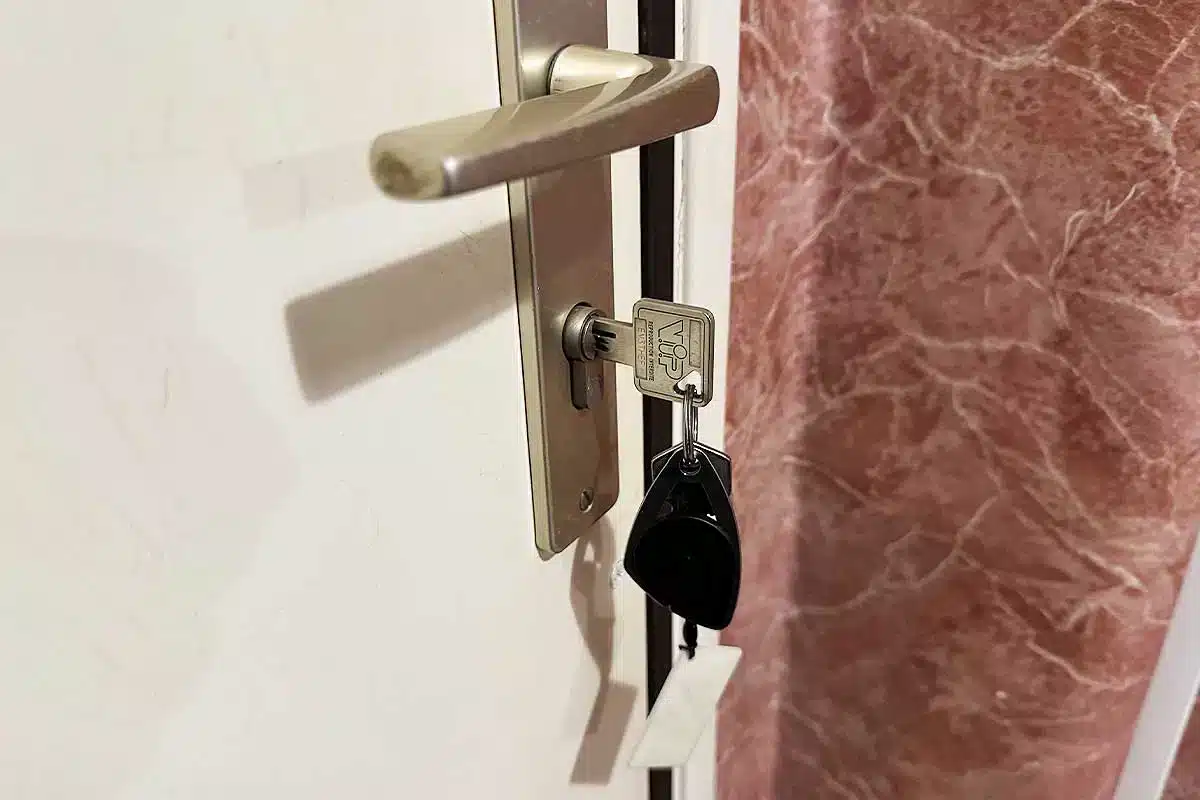Leaving keys in the door lock at night may seem like a practical security habit, but this approach actually introduces significant vulnerabilities. Many hold the home security misconception that keeping keys inside the lock discourages intruders, when in reality, it can decrease security and expose both property and residents to avoidable dangers.
Understanding the risks of leaving keys in the lock
This nightly routine, though reassuring at first glance, creates multiple opportunities for criminals and complicates emergency situations. By placing a key in the lock, several new threats emerge, often overlooked by those seeking simple solutions.
The increased risk of burglary is frequently underestimated. Intruders are quick to exploit predictable habits, especially when these routines make their job easier rather than more difficult.
How intruders exploit keys left in locks
Today’s burglars rarely rely on brute force. Instead, many prefer silent, sophisticated methods that capitalize on common lapses in judgment. The act of leaving keys in the lock provides an easy target for such techniques, making unauthorized entry far simpler.
With the aid of strong magnets or specialized tools, thieves can manipulate a key left in the cylinder from outside. What might feel like added protection actually delivers a straightforward opportunity for skilled individuals to unlock doors quietly and quickly.
Doors with nearby glass panels or letterboxes
When doors feature glass panes or a letterbox, additional risks arise. Intruders can access keys through broken glass or the letterbox slot, reaching inside within seconds. This turns what should be a deterrent into a clear advantage for those attempting to break in.
More break-ins now occur because keys are so easily reachable and visible from outside. This not only allows for faster entry, but also gives intruders a way to slip in unnoticed, leaving little evidence behind.
Key fishing and external manipulation tactics
Using long wires, hooks, or magnetic devices, burglars have refined ways to steal keys directly from locks without creating noise. Once the key is twisted or pulled from outside, the lock offers no resistance against such attacks.
The risk of key being picked from outside increases as criminals enhance their toolkits. Standard household doors provide minimal defense when targeted by these specific methods.
Safety hazards during emergencies
In urgent moments—such as medical crises, fires, or accidents—immediate access can save lives. Leaving a key jammed inside the lock can create emergency exit obstruction, preventing rapid help when it matters most.
If family members or neighbors possess a spare key, they may still be unable to enter if the lock is blocked from inside. This seemingly minor barrier can result in tragic consequences, turning manageable emergencies into disasters.
Fire safety concerns and critical delays
During a fire, every second is vital. Firefighters, paramedics, or police called to assist could face fire safety concerns due to delayed entry if keys remain stuck in the lock. In many apartments, doors require unlocking with a key from outside, and a blocked cylinder wastes precious time for rescuers.
This unnecessary delay forces emergency responders to attempt less effective entry methods, which can further endanger occupants and damage property.
Medical emergencies and accessibility issues
For elderly residents or anyone facing health emergencies, even a brief delay can be devastating. Doors complicated by internal keys impede support, sometimes leading to irreversible outcomes.
Relatives or neighbors holding duplicate keys quickly discover that their efforts are useless if the original key remains inside, amplifying the risk during critical interventions.
Unexpected costs and inconvenience from being locked out
A door slammed shut with the key on the interior side leaves residents stranded. Most modern locks will not turn, even with an authentic duplicate, when another key blocks the mechanism from inside.
Being locked out overnight brings stress and unplanned expenses. Emergency locksmith visits, especially after-hours or during weekends, can lead to costly bills and significant frustration.
- High charges for emergency locksmiths
- Extended waits in uncomfortable or unsafe environments
- Disrupted sleep and daily routines
- Potential damage to doors or locks during forced entry attempts
Those relying on outdated locking practices often face greater hassle and financial pressure, learning too late that convenience does not equal safety.
Why keys should be kept out of sight
Displaying valuable items where they can be seen from outside always increases risk. For home security, keys should be kept out of sight—away from windows, doors, and areas visible to passersby—to discourage opportunistic crimes.
Visible keys become invitations for repeat offenses. Storing them elsewhere adds an extra layer of difficulty, potentially deterring those looking for an easy target.
Better alternatives and modern security options
Clinging to old habits can sharply increase vulnerability. Embracing up-to-date technology and proven strategies ensures both greater safety and real peace of mind for all residents.
Double-cylinder locks allow unlocking from either side, even if a key is already inserted. Upgrading to these models removes practical obstacles faced during emergencies or accidental lockouts, providing added security and flexibility.
Smart locks and digital security systems
Replacing traditional locks with smart locks or fingerprint-based entry systems tackles multiple issues simultaneously. These advanced solutions offer remote monitoring, automated locking, and eliminate the reliance on physical keys—the main weakness of older systems.
Such innovations balance convenience with robust protection. Built-in authentication keeps access limited to authorized individuals, while backup codes or mobile apps ensure entry even during unexpected events.
Implementing secure habits and routines
Simple behavioral adjustments greatly improve overall safety. Removing keys from locks each evening, regularly checking entrance points, and informing all household members about secure practices reduces exposure to preventable danger.
Developing consistent routines raises awareness among everyone living in the home. Prioritizing reliable habits over risky shortcuts ensures better protection for both people and possessions.
Summary of common misconceptions about key placement at night
The belief that leaving keys in exterior locks deters burglars is refuted by security experts and law enforcement. In practice, this technique significantly decreases security and increases vulnerability.
Reevaluating nightly routines and investing in reliable updates are the best ways to shield loved ones and assets from harm. Modern tools and thoughtful everyday actions form the foundation of strong, dependable home security.








